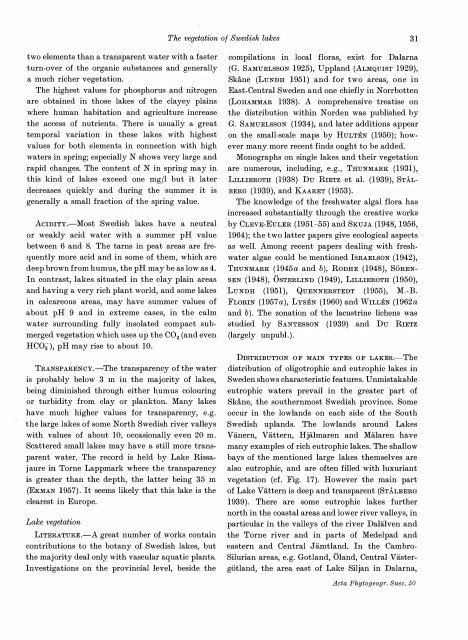You also want an ePaper? Increase the reach of your titles
YUMPU automatically turns print PDFs into web optimized ePapers that Google loves.
The vegetation of Swedish lakes 31two elements than a transparent water with a fasterturn-over of the organic substances and generallya much richer vegetation.The highest values for phosphorus and nitrogenare obtained in those lakes of the clayey plainswhere human habitation and agriculture increasethe access of nutrients. There is usually a greattemporal variation in these lakes with highestvalues for both elements in connection with highwaters in spring; especially N shows very large andrapid changes. The content of N in spring may inthis kind of lakes exceed one mgfl but it laterdecreases quickly and during the summer it isgenerally a small fraction of the spring value.ACIDITY.-Most Swedish lakes have a neutralor weakly acid water with a summer pH valuebetween 6 and 8. The tarns in peat areas are frequentlymore acid and in some of them, which aredeep brown from humus, the pH may be as low as 4.In contrast, lakes situated in the clay plain areasand having a very rich plant world, and some lakesin calcareous areas, may have summer values ofabout pH 9 and in extreme cases, in the calmwater surrounding fully insolated compact submergedvegetation which uses up the C02 (and evenHC03), pH may rise to about 10.TRANSPARENCY.-The transparency of the wateris probably below 3 m in the majority of lakes,being diminished through either humus colouringor turbidity from clay or plankton. Many lakeshave much higher values for transparency, e.g.the large lakes of some North Swedish river valleyswith values of about 10, occasionally even 20 m.Scattered small lakes may have a still more transparentwater. The record is held by Lake Rissajaurein Torne Lappmark where the transparencyis greater than the depth, the latter being 35 m{EKMAN 1957). It seems likely t'hat this lake is theclearest in Europe.Lake vegetationLITERATURE.-A great number of works containcontributions to the botany of Swedish lakes, butthe majority deal only with vascular aquatic plants.Investigations on the provincial level, beside thecompilations in local floras, exist for Dalarna(G. SAMUELSSON 1925), Uppland (ALMQUIST 1929),Skane (LUNDH 1951) and for two areas, one inEast-Central Sweden and one chiefly in Norrbotten(LoHAMMAR 1938). A comprehensive treatise onthe distribution within Norden was published byG. SAMUELSSON (1934), and later additions appearon the small-scale maps by HuLTEN (1950); howevermany more recent finds ought to be added.Monographs on. single lakes and their vegetationare numerous, including, e.g., THUNMARK (1931),LILLIEROTH (1938) Du RIETZ et al. (1939), ST.ALBERG (1939), and KAARET (1953).The knowledge of the freshwater algal flora hasincreased substantially through the creative worksby CLEVE-EULER (1951-55) and SKUJA (1948, 1956,1964); the two latter papers give ecological aspectsas well. Among recent papers dealing with freshwateralgae could be mentioned IsRAELSON (1942),THUNMARK (1945a and b), RODHE (1948), SORENSEN (1948), 0STERLIND (1949), LILLIEROTH (1950),LuNDH (1951), QuENNERSTEDT (1955), M.-B.FLORIN (1957 a), LYSEN (1960) and WILLEN (1962aand b). The zonation of the lacustrine lichens wasstudied by SANTESSON (1939) and Du RIETZ(largely unpubl.).DISTRIBUTION OF MAIN TYPES OF LAKES.-Thedistribution of oligotrophic and eutrophic lakes inSweden shows characteristic features. Unmistakableeutrophic waters prevail in the greater part ofSkane, the southernmost Swedish province. Someoccur in the lowlands on each side of the SouthSwedish uplands. The lowlands around LakesVanern, Vattern, Hjalmaren and Malaren havemany examples of rich eutrophic lakes. The shallowbays of the mentioned large lakes themselves arealso eutrophic, and are often filled with luxuriantvegetation (cf. Fig. 17). However the main partof Lake Vattern is deep and transparent (STALBERG1939). There are some eutrophic . lakes furthernorth in the coastal areas and lower river valleys, inparticular in the valleys of the river Dalfilven andthe Torne river and in parts of Medelpad andeastern and Central Jamtland. In the CambroSilurian areas, e.g. Gotland, Oland, Central Vastergotland,the area east of Lake Siljan in Dalarna,Acta Phytogeogr. Suec. 50
















